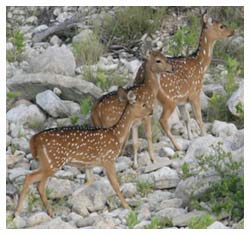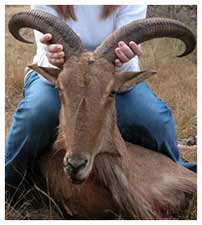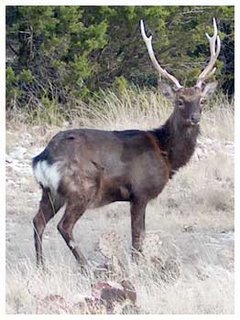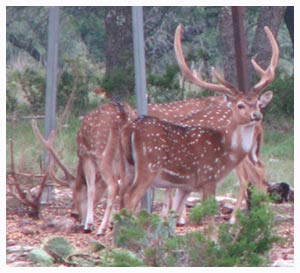Hunting Tips, Questions, Stories & Discussion
Focusing on managing Texas wildlife habitat and natural resources for native and exotic wild game species, for this and future generation of hunters and outdoor enthusiasts.Monday, June 29, 2009
What is the best way to prepare Texas Axis deer?
Regardless of how you choose to prepare Texas Axis deer meat is it important to not overcook this meat. It is best served medium to medium well, but never cooked all the way to well done. Well done venison is going to be both dry and tough, much more so than well done beef. This is largely due to the minimal fat and lack of marbling or distribution of fat through the lean muscle  tissue. Domestic animals have been bred to have fat and marbling while wild species are naturally lean and low fat.
tissue. Domestic animals have been bred to have fat and marbling while wild species are naturally lean and low fat.
What natural terrain is most favorable for hunting Texas Axis deer?
The Texas Axis deer is able to use their coloration to blend into the surroundings, especially around their favorite feeding locations. They tend to be found in the early morning and at dusk along the edge of wooden area, grazing out into open spaces. The background of the trees and wooded areas blends very well with their various shades of brown coats and the white spots further create a blending effect.
Since the nature preference for these deer is the wooded areas, feeders are typically placed just inside a clearing or along the inside edge of an opening. This natural placement of feeders encourages the natural behavior of the Texas Axis deer, but also draws them more into the open so hunters have a clearer line of sight for a shot.
Do the antlers of a Texas Axis deer grow each year or are they constantly on the bucks?
Like most deer, the Texas Axis deer bucks lose their antlers every year, according to when they were born. Every year the small buds, more specifically known as pedicels, start to grow in the spring, producing the first signs of antlers. These antlers are covered in velvet, which is rich in blood to nourish the growing cells within the antlers. When the antlers reach full size, which will vary from buck to buck, the blood supply is cut off due to hormonal changes as the rut approaches. This decrease in blood to the antlers causes the velvet to dry and the bucks rub their antlers against trees, rocks or shrubs to rid them of the old velvet.
At this point the antlers are in the best possible condition for a trophy mount. If the buck is not harvested over that season, in the winter the lack of blood to the antlers will result in a weakening of the bone structure at the skull, causing the antlers to actually fall off and the cycle to start again.
Labels: axis deer recipes, axis doe hunting, texas axis deer
Monday, June 22, 2009
I thought that these sheep did best in mountainous areas, how does that fit in for south Texas aoudad populations?
The south Texas Aoudad sheep are no less athletic than those that range into the mountains in Texas as well as New Mexico. The hill  country sheep are just as wily, alert and highly intelligent as those that live in the much more remote areas of the state. The south Texas Aoudads that live on managed game ranches often are slightly larger than the free range members of the species, plus they are not over hunted or decimated by extreme weather conditions or disease that can occur in wild herds.
country sheep are just as wily, alert and highly intelligent as those that live in the much more remote areas of the state. The south Texas Aoudads that live on managed game ranches often are slightly larger than the free range members of the species, plus they are not over hunted or decimated by extreme weather conditions or disease that can occur in wild herds.
Other than south Texas Aoudad sheep on managed game ranches or exotic game ranches, are there a lot in the wild?
For people that aren't used to the miles and miles of unfenced land in south and west Texas it may be surprising to know that most south Texas Aoudad sheep are actually on free range, not confined to a game ranches in the true sense. These game leases or ranches can run for literally hundreds of square miles of brush, rugged country and dirt roads. It is estimated that the original Barbary or Aoudad sheep that were brought over from Africa after World War ll quickly escaped from their fenced pastures and immediately began populating these huge grazing ranges and leases.
Based on different studies that include a lot of extrapolation from actual hard numbers, it is estimated by researchers that there are over 25,000 central, west and south Texas Aoudad sheep living in unconfined pastures and on grazing and hunting leases. The number of captive or contained Aoudad is not known, however they are likely to total at least another 10,000 or so animals.
What is the difference between shooting a male or a female south Texas Aoudad?
If you are looking for a lot of sporting opportunity there is really no difference between either the male or female when it comes to south Texas Aoudad hunts. In general the female is going to be lighter in total body weight plus she will not have the huge trophy horns that you could possibly get if you decided to go for a ram.
The females also don't have the distinguishing chaps, the heavy, long growth of hair on the front of the legs. Females don't have the highly prominent beard either, however they still make a terrific head mount or horn mount, your choice.
Labels: aoudad hunting, aoudad sheep hunting, texas aoudad hunts, trophy aoudad sheep
Why don't you need a license for exotic game hunting in Texas?
Basically as far as the Texas Parks and Wildlife Department
 is concerned, management with regards hunting of these exotics is based on the decision of the management of the exotic game hunting ranch. Game managers have to determine what is a reasonable number of males and females of each species to allow to be harvested each year. Incorrect management of the herds can result in low numbers for years to come or overcrowding of the grazing ranges within the given area. Most game managers are very good at what they do, ensuring that mature males and females in the right numbers are maintained to keep the herds at the appropriate levels for the hunters as well as the food supply.
is concerned, management with regards hunting of these exotics is based on the decision of the management of the exotic game hunting ranch. Game managers have to determine what is a reasonable number of males and females of each species to allow to be harvested each year. Incorrect management of the herds can result in low numbers for years to come or overcrowding of the grazing ranges within the given area. Most game managers are very good at what they do, ensuring that mature males and females in the right numbers are maintained to keep the herds at the appropriate levels for the hunters as well as the food supply.What happens to wounded animals in exotic game hunting situations that don't result in a kill?
All the guides and staff at exotic game hunting ranches are conservationists and managers by job description. As such they are responsible for ensuring, whenever possible, that all wounded animals are tracked down and killed as quickly as can occur. In reality there are very few seriously wounded animals that are not located and killed since they will leave a considerable trail for an experienced tracker.
Animals that are just grazed or have a slight flesh wound are often very quick to recover on their own. Of course guides watch the condition of the animals when they come to feed and any injured animals can be harvested as required. Ensuring that all hunters on the ranch work with guides also helps to cut down on any injured animals being left behind on the hunt.
Where can I go to get the meat properly processed?
Not all exotic game hunting ranches are going to provide field dressing and quartering of your kill, but this is a service offered by the staff at Escondido Ranch. After the meat is quartered and packed, you then have the option to take it to a wild meat processor in your area for further processing. Many hunters also butcher the animal themselves, there are several guides and charts available online that are simple to follow and give you the basic cuts. Making hamburger, sausage or even jerky with the meat is a simple and delicious way to make short work of butchering as well.
Labels: exotic deer hunts, south texas hunting ranch, texas exotic hunting ranch, texas hunting season
How distracted are Axis does coming into a feeder location?
 This can provide some very unique and beautiful wildlife photography or videography options, plus of course you will also have a chance to check out the does that are at the feeder while they are all focused in on the battle.
This can provide some very unique and beautiful wildlife photography or videography options, plus of course you will also have a chance to check out the does that are at the feeder while they are all focused in on the battle.
What Axis doe hunting tips are available for handling the beautiful hide?
If you want a very memorable and gorgeous addition to your hide collection you will definitely want to take the hide of your Axis doe as part of your reward for a successful hunt. The absolutely stunning deep coloration and the white spots forming the lines down the length of the body are idea as a wall hanging, a throw for the back of a couch or over a table or even as a rug. Talk to the guide and have the hide packed appropriately so it can be cleaned and prepared by your taxidermists. It is important to get the hide in for preserving as quickly as possible as waiting too long will result in hair loss and may even make it impossible to preserve with the hair on.
How often are Axis does found away from the herd or group?
Axis doe hunting tips and strategies always include hunting within a herd as these does virtually never split away from their group. The herd instinct is so strong with these animals that they just don't wander off on their own. The only time you are likely to see an Axis doe by herself is during the birthing process and if she is injured or ill. It is amazing to watch these animals even when startled as they whole herd seems to move as one, staying in a group even when fleeing.
As such it is important for hunters to wait until the whole herd arrives to the feeder or along the path before deciding which Axis doe is the right one to hunt. By shooting too early you risk the chance of not seeing the whole herd as they will take a few minutes to all arrive at the feeder. Typically they approach the feeder slowly and carefully, then when they determine the coast is clear or there are other animals already at the feeder they are much less hesitant and more interested in feeding and defending their territory from other groups of does.
Labels: axis doe hunt, doe hunting in texas, texas axis doe hunts, trophy texas axis deer
Archives
December 2008 January 2009 February 2009 April 2009 May 2009 June 2009 July 2009 August 2009 September 2009 November 2009 December 2009 January 2010 February 2010 March 2010 April 2010
Subscribe to Posts [Atom]
